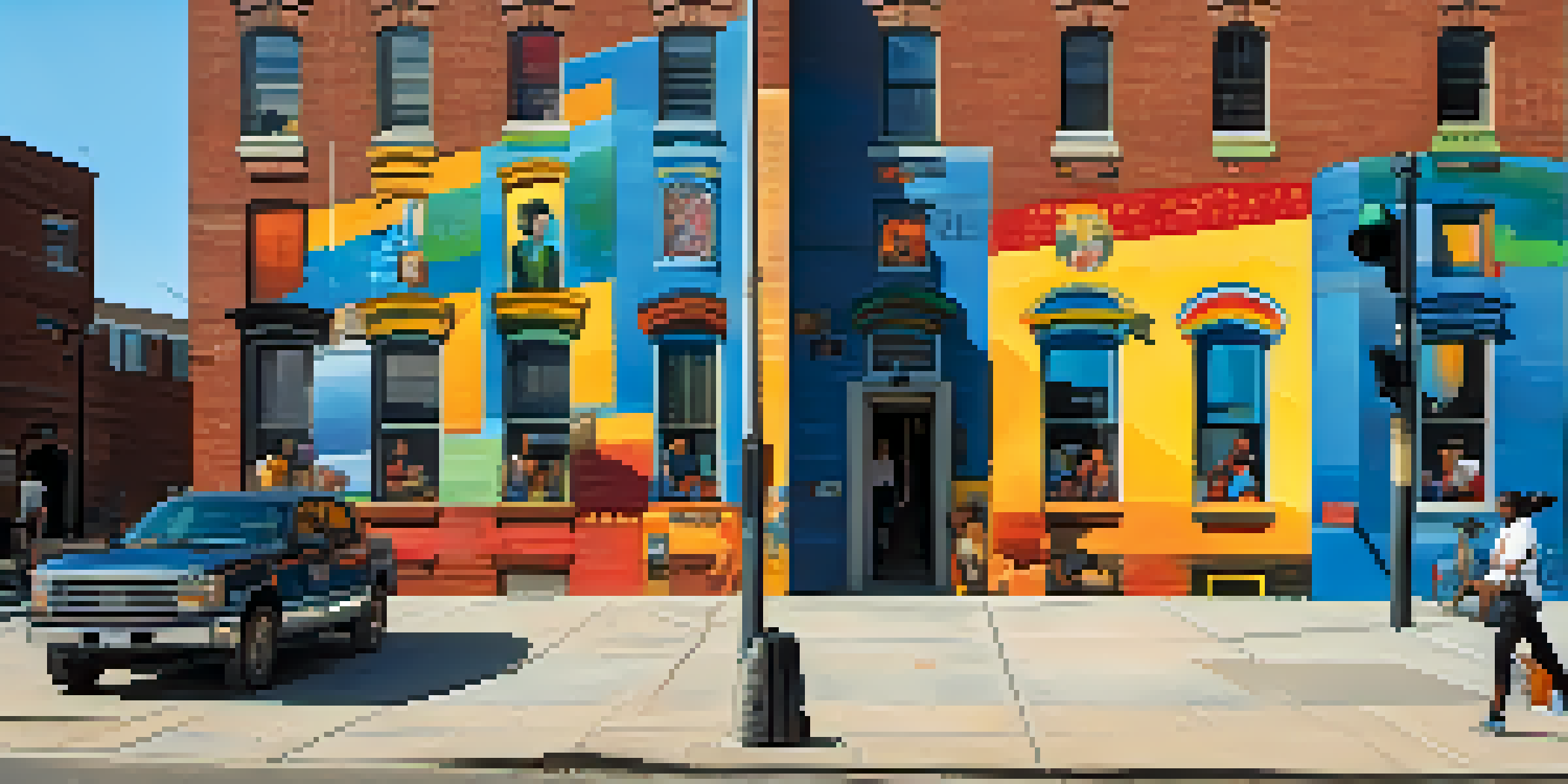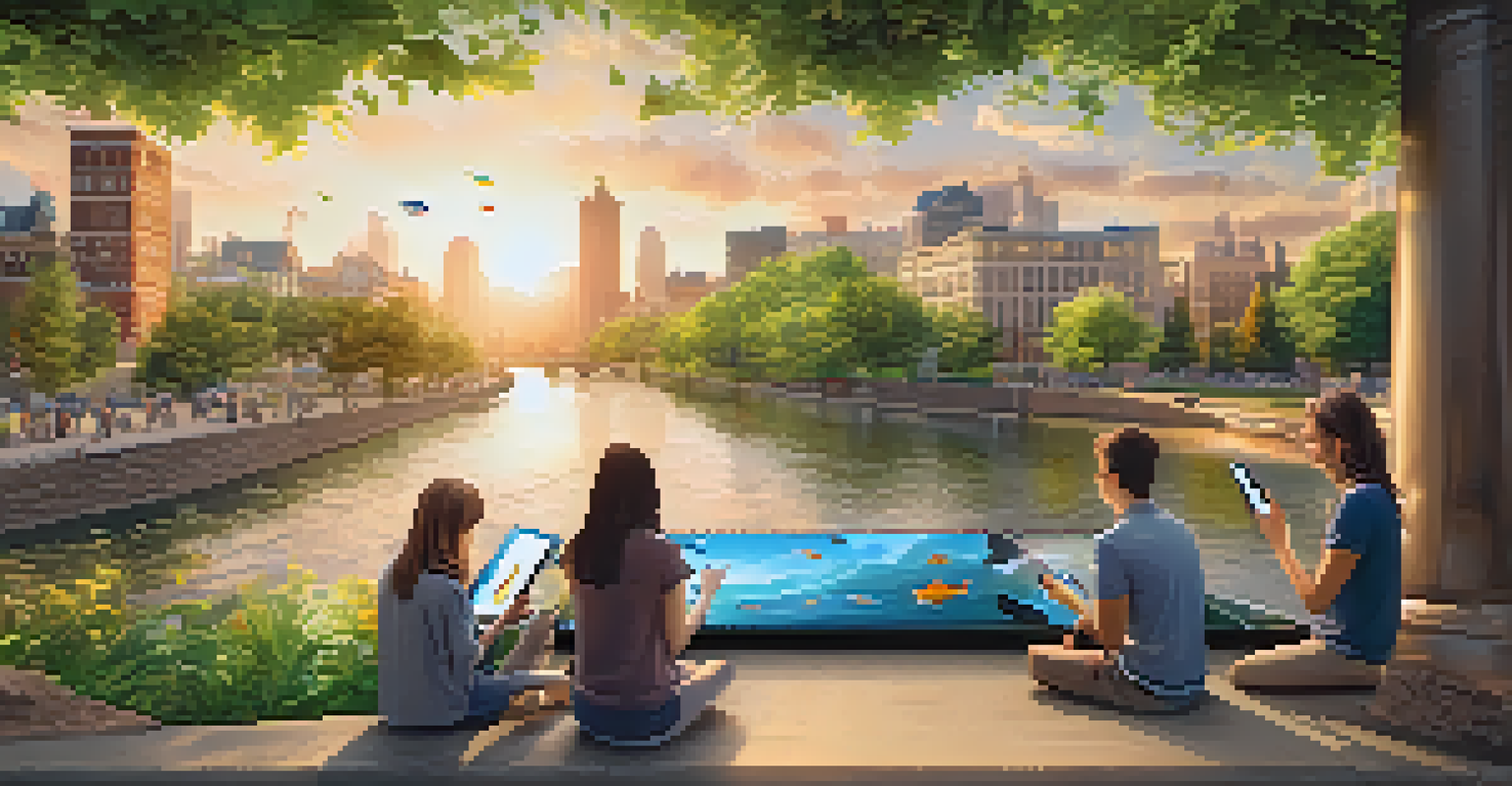The Rise of Digital Muralism in Urban Activism

What is Digital Muralism and Why Does It Matter?
Digital muralism blends traditional mural art with digital technology, creating vibrant public displays that can be easily updated and shared. This innovative form of expression resonates with urban activism by addressing social issues and community identity. As cities evolve, digital murals offer a dynamic way to engage residents and spark conversations about important topics.
Art is not what you see, but what you make others see.
By utilizing digital tools, artists are not only able to reach a wider audience but also adapt their messages to reflect current events. This adaptability makes digital muralism a powerful medium for activism, as it can respond quickly to societal changes. For example, during protests, artists have created digital murals that visually document the movement and amplify its message.
Moreover, digital muralism democratizes art, allowing anyone with a smartphone or computer to create and share their work. This accessibility encourages collaboration among artists and communities, fostering a sense of belonging and shared purpose. As urban environments become canvases for expression, the impact of digital muralism continues to grow.
The Role of Technology in Urban Activism
Technology plays a crucial role in amplifying the voice of urban activists through digital muralism. With social media platforms like Instagram and TikTok, artists can showcase their digital murals to a global audience in real time. This immediacy allows for real-time engagement and feedback, turning passive viewers into active participants in the conversation.

Additionally, augmented reality (AR) is revolutionizing how murals are experienced. With AR apps, users can point their devices at a mural and unlock additional layers of meaning, such as animations or hidden messages. This interactive element not only enhances the viewing experience but also encourages viewers to think critically about the issues being addressed.
Digital Muralism: Art Meets Activism
Digital muralism merges traditional art with technology to address social issues, fostering community engagement and activism.
As cities increasingly embrace smart technology, the integration of digital murals aligns perfectly with the urban landscape. They serve as both artistic expressions and informative tools, guiding citizens through important dialogues about their communities. In this way, technology not only enhances art but also empowers activism.
Digital Muralism as a Tool for Community Engagement
One of the most significant impacts of digital muralism is its ability to foster community engagement. When local artists create murals that reflect the culture and challenges of their neighborhoods, they invite residents to take pride in their surroundings. This sense of ownership can lead to greater community participation in local initiatives and events.
The role of the artist is to make the revolution irresistible.
For instance, community-led mural projects often involve residents in the design process, ensuring that the final artwork resonates with their collective identity. Such collaboration not only strengthens community bonds but also educates participants about the issues represented in the mural. By engaging residents in meaningful ways, digital muralism becomes a catalyst for grassroots movements.
Moreover, the visibility of these murals can attract attention from outside the community, often leading to increased support and resources for local causes. The more people that see and interact with these artworks, the greater the potential for advocacy and change. In this sense, digital muralism acts as a bridge connecting local voices to broader social movements.
Case Studies: Successful Digital Murals in Action
Examining successful examples of digital muralism can provide insights into its transformative potential. One notable case is the 'Black Lives Matter' mural in Washington, D.C., which became a powerful symbol of the movement. This mural not only captured national attention but also inspired similar projects across the country, prompting conversations about racial injustice and equality.
Another example is the use of digital murals to address climate change. In cities like San Francisco, artists have created interactive murals that depict the impact of rising sea levels. These artworks not only raise awareness but also encourage residents to engage with climate initiatives, highlighting the role of art in environmental activism.
Technology Enhances Community Voices
The use of social media and augmented reality allows artists to share their work globally, transforming passive viewers into active participants.
These case studies illustrate how digital murals can shift public perception and mobilize communities around pressing issues. By sharing these stories, we can inspire other cities to embrace digital muralism as a tool for activism and change.
Challenges Faced by Digital Muralists
Despite its growing popularity, digital muralism faces several challenges that artists must navigate. One significant issue is the balance between artistic expression and community approval. Artists often need to consider the diverse perspectives within a community, which can lead to debates about representation and appropriateness.
Additionally, digital muralists must contend with the impermanence of their work. Digital murals can be easily altered or erased, sometimes without the artist's consent. This transience poses questions about ownership and the survival of artistic messages in an ever-changing urban landscape.
Finally, funding and resources can be a barrier for many artists looking to create impactful digital murals. While technology has made art more accessible, not all artists have the means to utilize advanced tools or public platforms. Overcoming these challenges requires collaboration between artists, communities, and local governments to ensure that digital muralism can thrive.
The Future of Digital Muralism in Urban Spaces
As urban environments continue to evolve, the future of digital muralism looks promising. With advancements in technology, artists will have more tools at their disposal to experiment and innovate. From immersive installations to interactive displays, the possibilities for creative expression are endless.
Moreover, as social movements gain momentum worldwide, the demand for visual storytelling will likely increase. Digital murals can play a significant role in capturing and conveying the emotions and narratives of these movements. By bridging the gap between art and activism, digital muralism can help sustain the dialogue around social issues.
Challenges for Digital Muralists
Artists face issues like community approval, the impermanence of digital art, and funding barriers, which require collaboration to overcome.
Finally, as cities prioritize public art, digital muralism can become a staple in urban planning. By incorporating these artworks into public spaces, cities can create environments that reflect their values and aspirations. This integration will not only beautify urban landscapes but also empower communities to engage with the issues that matter most.
Conclusion: Embracing Digital Muralism for Change
Digital muralism represents a unique intersection of art, technology, and activism, making it a vital tool for urban change. By harnessing the power of digital technology, artists can create murals that resonate with communities and inspire action. These artworks not only beautify public spaces but also serve as a voice for those who may feel unheard.
As we have seen through various case studies, digital murals can mobilize communities, spark conversations, and bring awareness to pressing social issues. The potential for impact is immense, particularly as more artists and activists embrace this medium. It’s a call to action for cities to invest in public art that reflects the diverse narratives of their residents.

In embracing digital muralism, we open the door to a more inclusive and engaged society. As communities come together to create and interact with these artworks, they cultivate a deeper understanding of their shared experiences. Ultimately, digital muralism is not just about art—it's about creating a movement for change.